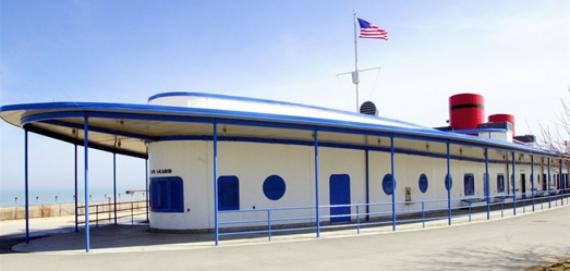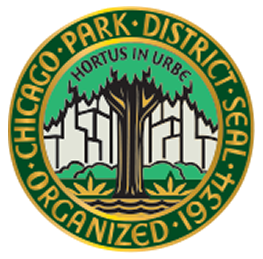1601 N. Jean-Baptiste Pointe DuSable Lake Shore Drive
Chicago, IL 60611
at North Ave. and Lake Michigan
Rules
- Swim only when lifeguards are on duty.
- Follow lifeguards’ instructions.
- Only Coast Guard approved personal flotation devices (PFDs) are permitted. Person-children wearing PFDs should have adult present.
- No smoking.
- No alcohol.
- No dogs on the beach.
- Do not feed birds or wildlife.
- Dispose of trash and recycling in appropriate containers.
- Grill in designated areas only and dispose of coals in red barrels.
- Keep accessible beach walks clear. No bicycling, skateboarding or rollerblading is permitted in these areas.
- Access to the Lake Michigan Water Trail for sports such as kayaking, canoeing and other non-motorized board or paddle sports is allowed at North Avenue Beach inside the "hook" at the southern end of the beach.
- No surfing or kiteboarding. Kiteboarding is ONLY permitted at Montrose Beach.
Hours
Park Hours
Hours Notes
The beach is open from 6 am to 11 pm, but swimming is only permitted during the beach season when lifeguards are on duty from 11 am to 7 pm, in designated swim areas. The beach season runs from the Friday before Memorial Day, through Labor Day.
Description
North Avenue Beach is located in Lincoln Park at 1600 N. Jean-Baptiste Pointe DuSable Lake Shore Drive (North Ave. @ Lake Michigan). As one of Chicago's most popular beaches, the beach features a unique and popular beach house that contains 22,000 square feet of space that features something for everyone and is permanently docked along this popular beach. This sleek, ocean liner-inspired building, decked out in a crisp blue and white, boasts one of the best views in the city. The beach house has upper decks and portholes for looking at the magnificent horizon or the multitudes of bikers, runners, walkers, and rollerbladers streaming down the lakefront trail. In May 2000, Mayor Richard M. Daley dedicated the North Avenue Beach House during a grand opening event for the public that included games for kids, free sand pails, refreshments, and a jazz band.
North Avenue Beach offers an array of amenities and recreational opportunities for beachgoers to enjoy that include:
- Castaways Bar and Grill is the best location on North Avenue Beach for great food and ice-cold drinks. The first level features an ice cream café and beachside burgers with casual walk-up stands. The rooftop features tasty appetizers, sandwiches, fresh salads, and refreshing desserts.
- Rent, repair or buy a bike from Lakeshore Bike 'n Tune right at North Avenue Beach!
- NAB Sports offers one of a kind open-air sports facility at North Avenue Beach offering roller hockey, dodgeball, fitness classes, hockey and dodgeball tournaments, and exciting special events.
- Sun and Moon Beach Yoga offers outdoor beach yoga seven days a week at North Avenue Beach for all levels during sun-rise, late morning, and during sunset.
- Boucher Brothers offering top of the line luxury lounge chairs and large umbrellas.
- Food concessions from Pronto Pups offering beverages and hotdogs on a stick, Stefani's Restaurant next to the hockey rink, and cotton candy.
- Great Lakes Board Company offers beachgoers a chance to hit the waves with wakeboard and paddleboard rentals.
- Kayak Chicago, the premier full-service outfitter in Chicago, offers kayak rentals at North Avenue Beach.
- Rent jet skis from Windy City Watersports!
- Retail vendor selling Havaianas Sandals.
- Retail vendors selling clothes, sundries, souvenirs, and beverages.
- Rent volleyball courts and equipment by calling (312) 742-3776. Courts rent for $10 per hour. Equipment rental is $10 with a valid ID. Reserve up to six days in advance.
There is an ADA accessible beach walk and restrooms available. Three ATM machines are located at the beach house.
Distance swimming is available at beaches 3 & 4 (north of boathouse), parallel to the shore. The paid parking lot is also available with limited parking; therefore, public transportation is highly encouraged.
For questions regarding Chicago beaches, email beaches3@chicagoparkdistrict.com.
History
Lincoln Park began as a public cemetery in the 1830s. Recognizing that the lakeside burial ground posed a public health threat, early citizens rallied to transform the site into parkland. A sixty acre unused part of the burial ground was first designated as Lake Park in 1860, and five years later the city renamed the site as Lincoln Park, providing a substantial budget for improvements. Over the years, Lincoln Park has grown to a landscape of over 1200 acres, particularly through many landfill extensions. In the late 1930s, a major landfill addition that stretched from Fullerton Avenue to North Avenue accounts for most of what is now the North Avenue Beach. Decades earlier, there was only a narrow paved beach that edged Lake Shore Drive in this area.
In 1934, the Lincoln Park Commission became part of the newly consolidated Chicago Park District and the new agency received substantial funding through President Franklin Delano Roosevelt’s New Deal. The completion of North Avenue Beach was one of many projects in Lincoln Park funded through the Works Progress Administration (WPA). Construction began in 1939 and the $1,250,000 project included a major improvement to Lake Shore Drive with grade separation providing a new overpass at North Avenue. The new North Avenue Beach, totaled more than 875,000 square feet of new parkland and extended all the way to Fullerton Avenue. Chicago Park District architect Emanuel V. Buchsbaum designed the new Art Moderne style North Avenue Beach House to emulate a lake ship. The North Avenue Beach and Beach House were dedicated in July of 1940. Over the years, the frame beach house had become so deteriorated that it had to be demolished. The original building inspired the design of a similar although somewhat large building composed of cast-in-place concrete. Designed by Wheeler Kearns Architects, the new structure was built in 1999.
Parking/Directions
Parking
Parking is available in a paid lot. Get rates and additional information.
Public Transit
For directions using public transportation visit www.transitchicago.com.
Map & Facilities
North Ave. Beach - Beach Concierge Concession
North Ave. & Lake Michigan
Chicago, IL 60613
United States
North Ave. Beach - El Campeon | Concession
North Ave. & Lake Michigan
Chicago, IL 60613
United States
North Ave. Beach - Chicago SUP | Concession
North Ave. & Lake Michigan
Chicago, IL 60613
United States
North Ave. Beach - Clark St. Sports | Concession
North Ave. & Lake Michigan
Chicago, IL 60613
United States
North Ave. Beach - Dagashi | Concession
North Ave. Beach - Jet Ski Chicago | Concession
North Ave. & Lake Michigan
Chicago, IL 60613
United States
North Ave. Beach - Kayak Chicago | Concession
North Ave. & Lake Michigan
Chicago, IL 60613
United States
North Ave. Beach - La Playa News & Gift | Concession
North Ave. & Lake Michigan
Chicago, IL 60613
United States
North Ave. Beach - Stefani's (Castaways) | Concession
North Ave. & Lake Michigan
Chicago, IL 60613
United States
North Avenue Beach Chess Tables
1600 N. Jean-Baptiste Pointe DuSable Lake Shore Drive
Chicago, IL 60613
United States
North Avenue Beach House
1501 N. Jean-Baptiste Pointe DuSable Lake Shore Drive
Chicago, IL 60610
United States





